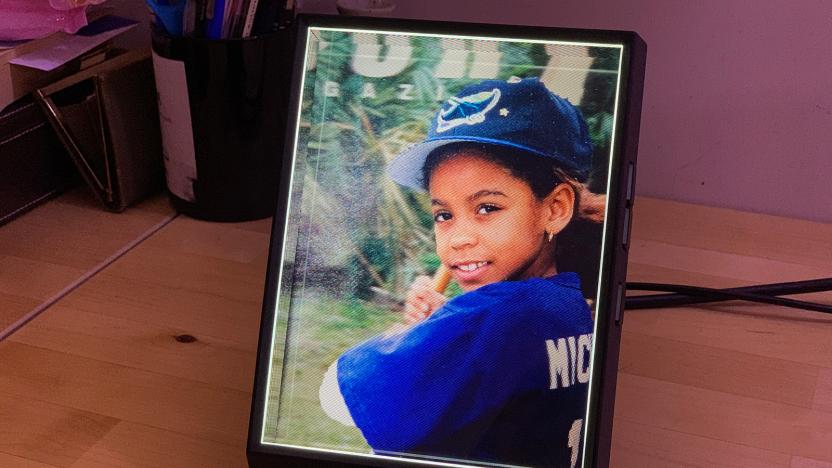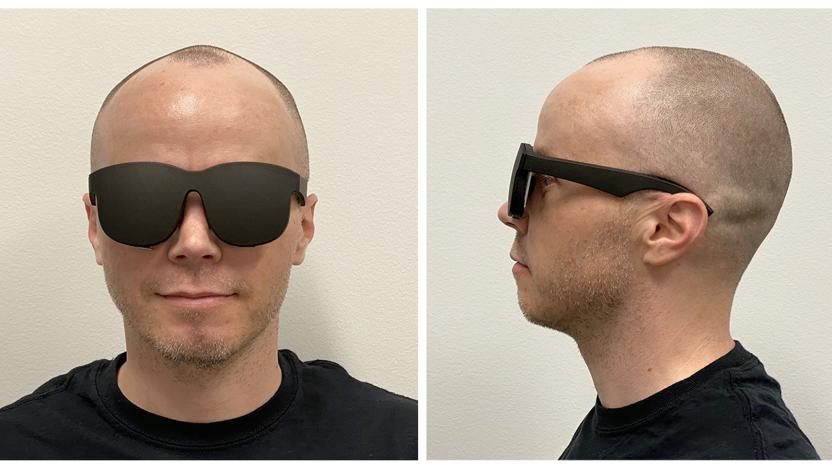Holography
Latest

Looking Glass says it can turn any photo into a hologram
Looking Glass Factory has unveiled a service that promises to turn any photo into a 3D holographic image.

Facebook envisions using holographics for super-slim VR glasses
Facebook researchers are exploring holographic displays that could lead to very thin and light VR glasses.

Infrared holography lets rescuers see people through walls, fire, walls of fire (video)
Firefighters already use infrared cameras to find people in burning buildings, but the technology can't distinguish between a person's heat and that of the surrounding fire. That's because a zoom lens is needed to concentrate the infrared rays in a way that enables the apparatus to form a human-readable image. Fortunately, a team of researchers from the Italian Institute of Optics has developed a system that ditches the lens in favor of digital holography that produces detailed 3D images in the darkness. The hardware isn't out of short trousers just yet, but the team is planning to develop a portable version for field work -- and chief Pietro Ferraro hopes that the idea will be co-opted by the aerospace and biomedical industries, too. Curious to see what all the fuss is about? Head on past the break for a video.

Microsoft TechForum unveils three research projects (video)
TechForum is a Microsoft-sponsored shindig where the company can get together, party, and then show off its latest and greatest research projects. First up we've got a transparent interactive 3D display which builds on technology from Cambridge University's HoloDesk project. Next is Holoflector, a "magic mirror" that overlays LCD projections onto your reflection. Both of these two projects rely heavily upon Kinect as more projects find the potential in the little sensor. Finally there's Illumishare, a pair of overhead projectors / cameras that share a desktop space with a colleague when you need to look at the same thing. After the break you can see all three concepts in action and you can learn a little more about each at our source links.[Thanks, Lokitoth]

ZScape 3D holographic prints take maps to the next dimension, sans spectacles
As the video above shows, Zebra Imaging's so called ZScape prints pull off some pretty amazing 3D visual effects despite being based on old school hologram technology. These prints are made using a variety of 3D data sources -- think AutoCad and the like -- that are then rendered as thousands of holographic elements by recording laser light onto a single film-based material. The resulting images are easily viewed without glasses or spinning mirrors, and just require a run-of-the-mill halogen or LED light source to reveal 360-degree, full color representations -- akin to what a physical model might look like. Fancier versions can also be made using overlays and layering techniques to show more information. To date, over 8,000 ZScapes have already been developed for the US military, but surprisingly their prices range between $1,500 for a 12- x 18-inch version to $3,500 for the largest 2- x 3-foot size, making them relatively obtainable for those not on Defense Department tabs. If the video of Seattle pulling an Inception above didn't impress you enough, be sure to check another embedded video after the break.

NICT's fVisiOn makes you see immaterial bunnies (video)
Japan's National Institute of Information and Communications Technology (NICT) has been chasing holographic damsels in distress for as long as we can remember, and honestly, the technology's still not quite there, but the team that brought us the gCubik has managed to create a low-res 3D hologram table that impresses anyhow. Using an twist on the famous optical illusion toys that use convex mirrors to make objects appear to float in the air, NICT hits a specially-designed optical filter cone with the light from 96 pico projectors. The result is a series of familiar-looking rabbits, teapots and the occasional rubber duck standing five centimeters high and visible through 120 degrees, a good sight better than the two-degree radius afforded them by the original technology. The best part is there's no case enclosing these creations, unlike competing ideas, so we'll eventually see 360-degree tables where your fingers can frolic alongside the ethereal leporidae. Watch the lead researcher demo a prototype after the break.

Japan still looking into holographic broadcasts for World Cup 2022
Sure, we'd prefer if Japan spent its time working on giant mecha suits to combat any potential alien threats, but right now the National Institute of Information and Communications Studies seems focused on trying to create holographic broadcast technology in an effort to secure Japan as the location for the World Cup in 2022. According to Variety, the team has already developed real time color holography in 3D for small toys and other objects, and plans to show off the technology using 8K Super Hi-Vision Cameras at CEATEC in October. Research leader Taiichiro Kurita compares the work done so far to the decades it took to perfect high definition TV and supposes live holographic broadcasts could be as little as 15-20 years away. Of course, to get there, they'll need more funding to continue research and so far the commercial giants are unsure if there's real product coming anytime soon -- we've got $5 on it, anyone else?

NICT researchers develop new method to make holography more practical
It's still not quite point-and-shoot, but it looks like some researchers at Japan's National Institute of Information and Communications Technology (or NICT) have gone some ways towards making holography a tiny bit more practical. As Tech-On reports, their method is based around a fly-eye lens that consists of a number of micro lenses, which allows for moving images to be captured in normal lighting conditions, and is also used to display the image after a computer works its magic on the raw images. There are still a few fairly significant drawbacks to the setup, however, as the image displayed is currently limited to one centimeter in size with a two degree viewing angle, although the researchers say they should be able to increase that to a four centimeters within the next three years. Check out an equally tiny image of an actual hologram captured with the system after the break.

CNRS learns to control nanoscale strain in CPUs, heads to Jedi training
We've always heard that Chewbacca and friends had the power to control nanoscale strain in processors in a galaxy far, far away, but we Earthlings are just now getting caught up. Researchers at the Centre d'élaboration de matériaux et d'études structurales (CEMES-CNRS) have reportedly patented a measurement device that will essentially "enable manufacturers to improve microprocessor production methods and optimize future computers." We'll warn you, the meat of this stuff is pretty technical, but the take home is this: the technique has a good chance at "optimizing strain modeling in transistors and enhancing their electrical efficiency," which is just what we need for more potent chips that demand less energy. And that's something even a layman can appreciate.

SeeReal demonstrates prototype holographic display
Three-dimensional displays have long been fodder for a good laugh, but Germany's SeeReal is taking a serious approach with its latest holographic prototype. Showing its stuff at the Society for International Display (SID) forum in California, the company has reportedly "developed a new technology for displaying 3D images on a TV set, computer display, or through a projector." The trick is seemingly in the company's proprietary Tracked Viewing Window technology, which "limits pixel size to HDTV levels and in combination with a real-time tracking system, eliminates superfluous elements while reducing the need for real-time processing." The firm's main objective was to remove the inconvenience factor that's typically associated with viewing 3D imagery, and with its unique use of holography, it has reportedly done so. Of course, the outfit is still on the hunt for willing and able partners to kick out products to the commercial world, but according to the CEO, it already has "a number of promising contacts in that regard."[Via PCLaunches]

MIT researchers tout "practical" holographic video
A team of researchers at MIT seem to think they've finally come up with a way to make holographic video a bit more practical for everyday use, touting the new system they've developed as a possible display for PCs and video game consoles, Technology Review reports. According to the researchers, the display will be small enough to fit in an entertainment center when finished, boast a resolution as good as a standard analog television, and only cost a "couple of hundred dollars." Much of that increased practicality comes from the fact that this latest version, dubbed the Mark III, simply relies on a standard graphics processor instead of specialized hardware. The researchers also managed to streamline some of the other optical hardware, which they say made the previous incarnations as big as a dining-room table. It apparently still has a few drawbacks, however, with it currently only able to display monochromatic holograms in a space about the size of a Rubik's Cube. They insist that's only a temporary problem though, and promise that the next model will be comparable in size to a desktop monitor and boast a full range of color. No word if there'll also be a port of everybody's favorite quasi-holographic arcade game, Time Traveler, to go along with it, but we can hope.

NICT and Kobe University team up to form "floating visual" 3D display
While making concrete slabs double as displays may prove useful when dressing up those otherwise drab skyscrapers, creating 3D-like images from real objects throws in a much-needed dash of geekiness. The National Institute of Information and Communications Technology (NICT) and Kobe University have partnered to craft "a thin-panel type device which forms 3D images in the air." Although 3D devices have a less-than-stellar track record when it comes to overcoming the "gimmick" stereotype, this rendition looks to have a bit more potential than usual. This offering is made by forming a "100 μm-thick Ni layer" on a glass plate, and punching a bevy of 100 μm square holes in it; when objects (such as the toy ball pictured above) are placed below the table, a "floating visual" appears. Moreover, this rendition doesn't require viewers to look from certain angles or with certain lighting scenarios like many forms of holography oftentimes do, and the team hopes to eventually conjure a 3D image of a human "if they can substantially enlarge the device size" while keeping its current attributes in tact.[Via The Raw Feed]




